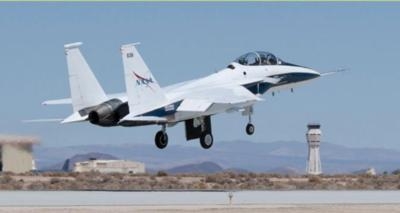Mon, Jul 22, 2013
Small Test Airfoil Being Evaluated In Conjunction With Aerion Corporation
NASA Dryden Flight Research Center’s F-15B Research Testbed aircraft has been busy this year, flying an experimental test fixture in partnership with Aerion Corporation of Reno, Nevada.

Called the Supersonic Boundary Layer Transition, Phase II, or SBLT-II, the experiment consists of flying a small test airfoil, or wing section, attached underneath the F-15B. This allows NASA and Aerion engineers to continue investigating the extent and robustness of natural laminar flow over the test section at supersonic speeds.
Conducting the experiment in actual supersonic flight conditions with the F-15B enables engineers to capture data in a real-world flight environment, allowing for more precise refining of supersonic natural laminar flow airfoil design. “The objective of the flight series is to investigate the extent and robustness of smooth, or laminar, airflow over the specially-designed test airfoil,” said Brett Pauer, NASA Dryden’s deputy High Speed Project manager. “Then, researchers will work to better understand when imperfections in the airfoil’s surface cause the air to transition from laminar to rough, turbulent flow. The greater the extent of laminar airflow over a wing, the less aerodynamic drag there is, which reduces fuel consumption,” Pauer said.
It is believed that significant laminar flow has never been achieved on any production supersonic aircraft before, so this research and the data being collected from the SBLT-II test fixture may help provide some of the data that might enable the design of supersonic aircraft in the future that have wings that produce laminar flow at supersonic cruise conditions.
One of the goals of NASA’s High Speed Project, which utilizes the F-15B and other high performance jets, is reducing the fuel consumption and increasing efficiency of future supersonic aircraft.
(Image provided by NASA.)
More News
Known Traffic With respect to ATC clearances, means aircraft whose altitude, position, and intentions are known to ATC.>[...]
Aero Linx: Aviation Suppliers Association (ASA) Established February 25, 1993, the Aviation Suppliers Association (ASA), based in Washington, D.C., is a not-for-profit association,>[...]
Abeam An aircraft is “abeam” a fix, point, or object when that fix, point, or object is approximately 90 degrees to the right or left of the aircraft track. Abeam indic>[...]
Aero Linx: The Air Charter Safety Alliance The group, called the Air Charter Safety Alliance, will raise awareness of illegal charter flights among potential customers, charter bro>[...]
“For months, ALPA has been sounding the alarm on the ongoing efforts by some aircraft manufacturers to remove pilots from the flight deck and replace them with automation. To>[...]
 ANN's Daily Aero-Term (06.10.24): Known Traffic
ANN's Daily Aero-Term (06.10.24): Known Traffic ANN's Daily Aero-Linx (06.10.24)
ANN's Daily Aero-Linx (06.10.24) ANN's Daily Aero-Term (06.11.24): Abeam
ANN's Daily Aero-Term (06.11.24): Abeam ANN's Daily Aero-Linx (06.11.24)
ANN's Daily Aero-Linx (06.11.24) Aero-News: Quote of the Day (06.11.24)
Aero-News: Quote of the Day (06.11.24)



